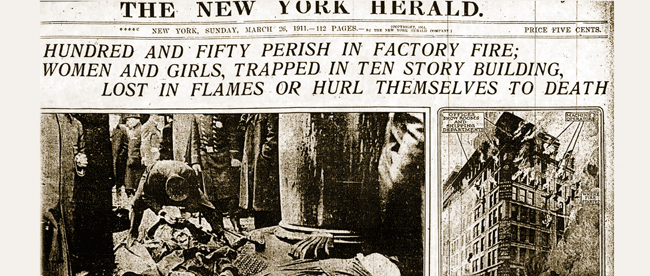Do you know how your clothing was made?
This week marks the 100th anniversary of the Triangle Shirtwaist Factory fire, the worst industrial disaster in New York City’s history. Unable to escape, 146 garment workers died, most of them young immigrant women. That March 25, 1911, their workplace had no fire alarm, many exits were locked from the outside and the factory’s single fire escape collapsed. Dozens of people fell or jumped to their deaths from the eighth, ninth and tenth floors of the burning building. It was a tragedy for all New Yorkers, and is still commemorated today.
Garment workers then as now were lower status citizens, their conditions ignored until the horror of that fire. After 30,000 New Yorkers marched to remember the victims, among the public outcry came successful calls for greater regulation of industrial workplaces. The fire helped catalyze the birth of the modern labour movement.
Many workplaces of the day were dangerous. In the 18 months leading up to the fire, thousands of New York City garment workers had been on strike, demanding fair wages and greater safety, such as adequate fire escapes and unlocked doors. As the protests continued, many factories voluntarily improved working conditions, but not the rabidly anti-union Triangle Waist Company. Its employees paid the ultimate price.
One hundred years later, most of North America’s clothing manufacturing has moved overseas, where many workers are currently fighting for similar protection. Although garment industries across Asia employ millions and are growing rapidly, wages and working conditions often leave much to be desired. On International Women’s Day earlier this month, garment workers in the Indian city of Bangalore, two thirds of them women, staged a protest. Similar protests have taken place recently in Bangladesh and Cambodia. And last December, more than two dozen garment workers were killed in a factory fire near Dhaka in Bangladesh, the stairwell exit locked. It was not an isolated incident.
I sometimes see clothing priced so low that I cannot conceive how it could have been produced responsibly and without exploitation. This disturbs me. As a mother of three and a consumer, I think about my impact both on the environment and on other people. Because I design and produce clothing, I thoughtfully plan every stage of its production, ensuring that it is ethical and efficient. I choose my fabrics carefully and keep waste to a minimum. With high quality for longevity, I consider the lifespan of a piece of clothing, including its buttons, label and trim.
It is hard to know the conditions in which clothing is produced. If sustainable fabrics are important to you, highly regulated organic certification and labeling help. But it is harder to tell how the person who sewed your jeans was treated. Here, you can partly rely on fair trade or union labeling. Many clothing companies now have information about their manufacturing processes on their websites, although ethics and working conditions are often far from transparent. If this is important to you, it is worth taking the time to search for companies with a proven commitment to fair practices. Many of us are increasingly tuned in to the way our food is grown and produced; I wonder if similar concern might apply to how people buy clothing.
As a consumer, I try to buy fewer things, making sure of the quality, and then wear them for years, rather than treating my clothing as seasonal/disposable. I apply the same principle when I am designing because I think it is a huge benefit to my customers. If a dress can be worn over time, as a child grows, and then passed along, and still look great because the fabrics are excellent, then that healthy dress will last beautifully.
My husband, a teacher, spotted one of my earliest caterpillar dresses on one of his kindergarten pupils recently, and mentioned it to the girl’s mother. She regaled him with the story of the dress and the three children who have worn it continuously for six years. That’s a dress I can feel good about.

